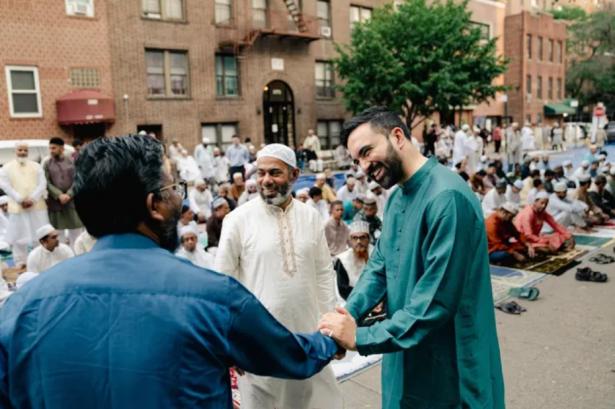With only about 100 days until early voting begins, a large slice of the city’s political Establishment, backed by big-money donors, is mounting a last-ditch effort to stop Zohran Mamdani from being elected New York’s next mayor.
Despite his crushing loss in the Democratic primary, Andrew Cuomo announced he’s running in the general election — and “in it to win it” — as an independent candidate, denouncing Mamdani as pushing “slick slogans, but no real solutions.”
Adams has been on a fundraising tear, raising $1 million in a single night. Eric Lerner, president of a political action committee, expects to raise another $5 million to $10 million from cryptocurrency donors for an independent committee supporting Adams’s reelection. “We need big dollars so that we can compete … buy media ads and do social media marketing,” he told Politico.
The question is whether either of these candidates can counter the enormous, six-to-one advantage Democrats enjoy in New York. After decades of pleading with New Yorkers to vote blue, it will be tricky for Cuomo and Adams to ask voters to oppose the party’s duly elected nominee.
The power brokers trying to pull off this unlikely stunt are certainly aware of that problem. But they face another one they seem unaware of: They are fighting against deep demographic and political shifts in New York that won’t be stopped by a few million dollars’ worth of ads.
In a town where all politics is tribal, Mamdani has emerged as a leader of New York’s South Asian community, 600,000 strong, which is now following its Irish, Italian, Jewish, Black, and Latino predecessors in demanding a seat at the table inside City Hall. That bloc is squarely behind Mamdani and fighting hard for victory in November.
Back in December, when Mamdani announced his campaign for mayor, I asked him to describe the city’s fast-growing South Asian communities around the city. Without missing a beat, he began rattling off a list of neighborhoods he’d clearly been thinking about. “There are far more Bangladeshis than maybe there are Indians across the five boroughs, whereas that wasn’t the case a few decades ago,” he told me. “Astoria has a significant Bangladeshi population, Parkchester has one as well, Flushing, Hillside Avenue. Midwood has a significant Pakistani population, Coney Island Avenue, Bath Beach and then also across Manhattan. But these are places that you really do feel just how much the South Asian community is intertwined with the fabric of the city, but that hasn’t been reflected in our politics. I mean it’s ridiculous that in 2020, I was the first South Asian man elected to any position.”
The political power of South Asian neighborhoods has long been divided and diluted by the Albany lawmakers who draw political boundary lines, says Mamdani. “You look at Richmond Hill, South Ozone. This is the largest area of South Asian New Yorkers in any one neighborhood district, and it was carved into seven or eight assembly districts,” he told me. “Now it’s about four, and that’s progress — but is it really?”
While the politicians were gerrymandering, community organizers were building grassroots activist groups like DRUM, which stands for Desis Rising Up and Moving. (The slang term Desi refers to immigrants from South Asia and parts of the Indian diaspora in Africa and the Caribbean.) Around the same time, Bhairavi Desai founded the Taxi Workers Alliance, which became an organizing hub for drivers.
For more than a decade, South Asian candidates have been running for various local offices — lately with more success. Lawyer Jennifer Rajukmar lost Assembly and City Council races before moving to western Queens, where she won an Ozone Park Assembly seat in 2020 on the same day Mamdani got elected; the two made history as the first Indian Americans ever elected to the State Legislature. The following year, community activist Shahana Hanif became the first Muslim woman and first Bangladeshi American elected to the City Council.
Over time, a political ecosystem has developed. Attorney Ali Najmi, the son of Pakistani immigrants, lost a race for City Council but remained active as co-founder of the Muslim Democratic Club and is now a savvy, seasoned election attorney. Amit Singh Bagga placed second to Julie Won in a crowded Council race, but as deputy director of the city’s 2020 census effort he played a critical role in making sure South Asians were located and counted; he later served as an adviser to Governor Kathy Hochul and is now a lobbyist.
Mamdani is not just a passive beneficiary of all this activity. A few years ago, when immigrant cab drivers were being squeezed in a financial trap that led to personal bankruptcies and a string of suicides, he was the only politician to join a hunger strike by drivers, which eventually led to economic relief from the de Blasio administration.
Cuomo, Adams, and other anti-Mamdani politicians who are horrified by Mamdani’s ties to the Democratic Socialists are missing the meaning of the current moment. Bagga says primary turnout more than doubled in many South Asian neighborhoods, and that level of excited mobilization is likely to grow in the general election.
Ever since the days when Irish immigrants began forming clubs, running candidates, and edging out Dutch- and British-born New Yorkers, new ethnic groups have banded together to get a better slice of the municipal pie. The rise of Mamdani represents a breakthrough moment for a South Asian voting bloc that has long been hiding in plain sight.
[Errol Louis is a columnist for New York Magazine and the longtime host of Inside City Hall on Spectrum News NY1.]


Spread the word